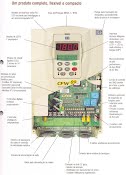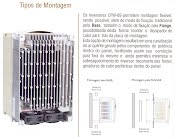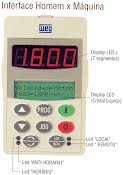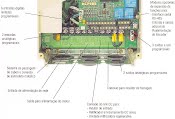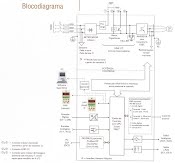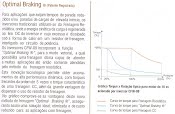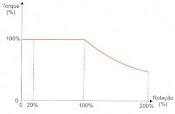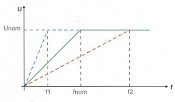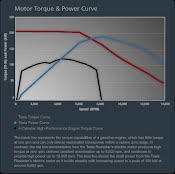IntroductionElectrical motors are reversible machines; they can function as motors or as generators. A motor receives electrical power from a battery and transforms it in torque developing a Counter Electromotive Force CEMF, which opposes the battery. A generator receives mechanical power from a mechanical actuator and transforms it in electrical power developing a Counter Torque, which opposes the actuator.
A motor behaves as motor and as generator at the same time. In fact while a motor is 'motoring', that is doing mechanical work, it generates CEMF acting as generator, although the CEMF is lower than the battery voltage so the motor acts as a load and absorbs current.
In certain situations the CEMF may overcome the battery, in which case the generator component becomes dominant; the motor acts as a generator inverting the direction of its current and forcing it into the battery.
The typical situation is the one of a heavy vehicle rolling on a sharp downhill slope and forcing the motor to turn fast enough that the CEMF becomes larger than the battery voltage. As soon as the motor overcomes the battery it inverts the current direction and starts feeding current into the battery, while developing a counter torque that acts as a brake. This phase is called regeneration (recharging of the battery).
The Voltage/Current plane
Two wire DC electrical devices have one of the two poles marked as positive. By convention this is the pole where the positive voltage applied or generated is located.
These devices are divided into two categories:
- Generators: Batteries, dynamos, fuel cells etc.
- Users: Resistors, ovens, motors etc.
The current is defined as positive if it enters the positive pole of a user, or exits the positive pole of a generator. See figure 1.
 FIGURE 1.
FIGURE 1.
Obviously it is possible to force a negative current on the positive pole.
As an example, a common car battery (generator) sources a positive current (exiting the positive pole) when starting the car and sinks a negative current (entering the positive pole) while being recharged.
Similarly current can be made to exit from the positive pole of a resistor (user) inverting the voltage across it. By representing positive and negative voltage/current in a plane as a VI axis, we distinguish four quadrants.
As an example let's look at a car battery (figure 2); Q1 and Q 3 are the quadrants where the battery acts as a generator, since the current exits the positive pole. In Q1 the generator maintains a positive power rail while in Q3 the battery maintains a negative power rail.
 FIGURE 2.
FIGURE 2.
Q2 and Q4 are the user quadrants, where the battery acts as a load to a battery charger that pushes current into the battery recharging it. In Q2 the battery charger output maintains a positive power rail, where in Q4 the charger maintains a negative power rail.
We will see shortly that a permanent magnet DC motor is also a four-quadrant device, acting as a user in Q1 and Q3, and as a generator in Q2 and Q4.
The motor as a four-quadrant deviceMost electrical motion operated by a battery use permanent magnet PM motors, since in this case no battery current needs to be spent to generate the magnetic field. Reversing the armature current reverses the direction of rotation.
The only exception is for very large vehicles, where high power motors are needed, beyond the capability of permanent magnets, In this case a 'separately excited' motor is used, mostly the shunt version which, as long as the field winding is feed at constant voltage, behaves like a PM motor (constant flux).
In practice, since the shunt motor may malfunction should the field current accidentally become zero, what is used is a variation of the shunt motor called 'compound'. A small series field winding is added, to guarantee a minimum amount of field as long as there is armature current. An advantage of the shunt motor is that direction is reversed by reversing the field current, rather than the much larger armature current.
The interesting characteristics of the permanent magnet motor are:
- Predictable behavior.
- Ability to develop maximum torque at startup, when speed is zero.
- Absence of run away condition, this being the situation where the motor indefinitely increases its speed, until it destroys itself (something that can happen with separately excited motors).
- Ideal in battery operation, since they do need to consume current to create the field flux.
 FIGURE 3.
FIGURE 3.
From now on we refer exclusively to PM motors; they are widely used in many applications up to several HP.
As previously shown, a motor is a reversible machine; it acts in four quadrants of the Voltage/Current plane.
The motor can be assigned a positive pole, which corresponds to one of the two senses of rotation, for example the one moving a vehicle forward. Let's assume this is the clock-wise CW direction (Q1). Inverting the armature current inverts the direction, which becomes counter-clock-wise CW (Q3).
Q1 and Q3 are the quadrants where the motor is motoring, that is absorbing electrical energy and making mechanical work. Q2 and Q4 are the quadrants where the motor is generating, that are it is mechanically pulled, like for example by an electrical golf cart going downhill, and it acts as a DC generator.
 FIGURE 4.
FIGURE 4.
It is useful to understand the equivalent circuit of a permanent motor. It is composed of a voltage generator equivalent to the Counter Electromotive Force CEMF, a series resistor equivalent to the resistance of the copper of the armature winding, and a series inductance.
 FIGURE 5.
FIGURE 5.
The figure above shows the electrical equivalent circuit. The flux of the motor is constant so it is incorporated in the constant.
Note that torque is proportional to armature current and CEMF is proportional to the speed; the faster the motor turns, the higher is the CEMF. If the motor is turned by an external agent (gravity on a steep downhill) the CEMF can exceed the voltage of the battery and recharge it.
Energy balance in a vehicleA moving vehicle has three energy components associated with its motion:
- Kinetic energy EK
- Potential energy EP
- Rotation energy ER
EK = ½MV2 where M is the mass and V is the speed (EQ 1)
EP = MgH where g = 9.8 m/sec2 is the gravity acceleration and H is the height (EQ 2)
ER = ½IW2 where I is the moment of inertia and W the angular velocity (EQ 3)
ER is normally very small and can be ignored (unless the vehicle is build on purpose with a heavy spinning wheel, such as boats using gyroscopic rotating masses for stabilization).
The total energy of the vehicle is:
Etot = EK + EP = M (½V2 + 10H) (EQ 4)
We have approximated gravity to 10 meter/second2.
A vehicle beginning an uphill slope will slow down losing kinetic energy (speed diminishes) while gaining potential energy (height increases). A vehicle beginning a downhill slope will lose potential energy (height decreases) and gain kinetic energy (speed increases).
A vehicle going over a summit with its motor disengaged will start moving downhill at constant acceleration until it will reach constant speed. This will happen when attrition and air resistance become sufficiently high to balance gravity. This is similar to a man parachuting who will initially fall at constant acceleration, until wind resistance will balance his speed and keep it constant.
A vehicle going over a summit with its motor engaged will behave in the same way, except that the motor will turn into a generator, effectively adding a braking effect to attrition and wind resistance so the vehicle will reach constant speed sooner and the speed will be lower.
Once the speed becomes constant, the kinetic energy remains constant; only the height decreases by a constant quantity over time. The delta Energy DEP is equal to:
DEP = 10M (H2 - H1) (EQ 5)
H2 is the initial and H1 is the final height. Let's assume in the last case for simplicity that attrition and wind resistance are negligible, then all the lost potential energy goes into the motor.
If we make the loss of altitude H2 - H12 equal to the loss in one second, then assuming the motor is connected to the battery, then the motor will transform in electrical power the lost Potential Energy per second.
Electrical Power = DEP = 10M (H2 - H1) (EQ 6)
Let's make an example.
A 300-kg electrical cart rolls downhill at a constant speed of 15 km/hour (about 10 mile/hour) on a 15% incline. Each second the cart covers four meters.
The loss of height per second is:
H2 - H1 = 4 x 0.15 = 0.6 meters. (EQ 7)
The loss of potential energy per second is:
DEP = 10 x 300 x 0.6 = 1,800 Joule per second (EQ 8)
In electrical terms this equates to 1.8 kW of electrical power.
The motor will generate an equivalent current (minus the generator efficiency), which will recharge the battery.
Coasting, Dynamic, Regenerative Braking
Let's assume we have an electric cart reaching a summit and then rolling downhill. As the cart passes the summit, the current in the motor drops to zero as no more torque is requested of the motor. The cart starts rolling downhill at constant acceleration, speeding up and forcing the motor to turn faster and faster so the CEMF increases until the motor turns fast enough that the CEMF exceeds the battery. At that moment the motor becomes a generator and the current will invert its direction and flow into the battery recharging it.
The motor, as generator, will develop a Counter Torque, (equivalent to the motor developing a CEMF) which will act as a brake. Eventually the Counter Torque and gravity will balance each other, at which point the cart will stop accelerating and will roll downhill at constant speed.
There are three ways a cart can be designed to handle a downhill:
| Coasting - The motor is disconnected and left floating. There is no braking effect from the motor and the cart will accelerate so to accumulate the maximum kinetic energy to help with the next uphill climb. Dynamic braking - The motor is detached from the battery and connected to a resistor. The potential energy lost downhill is dissipated as heat. The motor acts as a brake but the energy is lost as heat. Regenerative braking -The motor stays connected to the battery and the CEMF (once exceeding the battery) will recharge the battery. The motor acts as a brake and the lost potential energy is stored in the battery. Using a Power Supply
In some stationary applications a power supply may be used instead of a battery; in this case regenerative braking may become dangerous. A battery is a two-quadrant generator, capable of issuing (discharge) or receiving (recharge) current at constant voltage. A power supply in general is designed as a one-quadrant generator, designed for issuing current at constant voltage, but not for receiving it. If a power supply has to be used, then the best choice is a conventional power supply with large filtering output electrolytic capacitors; a regenerating motor will charge the capacitors and as long as the voltage does not exceed their maximum rating, the power supply will operate in two quadrants. A switching power supply is in general not suitable. |
Energy balance in a vehicleA moving vehicle has three energy components associated with its motion:
- Kinetic energy EK
- Potential energy EP
- Rotation energy ER
EK = ½MV2 where M is the mass and V is the speed (EQ 1)
EP = MgH where g = 9.8 m/sec2 is the gravity acceleration and H is the height (EQ 2)
ER = ½IW2 where I is the moment of inertia and W the angular velocity (EQ 3)
ER is normally very small and can be ignored (unless the vehicle is build on purpose with a heavy spinning wheel, such as boats using gyroscopic rotating masses for stabilization).
The total energy of the vehicle is:
Etot = EK + EP = M (½V2 + 10H) (EQ 4)
We have approximated gravity to 10 meter/second2.
A vehicle beginning an uphill slope will slow down losing kinetic energy (speed diminishes) while gaining potential energy (height increases). A vehicle beginning a downhill slope will lose potential energy (height decreases) and gain kinetic energy (speed increases).
A vehicle going over a summit with its motor disengaged will start moving downhill at constant acceleration until it will reach constant speed. This will happen when attrition and air resistance become sufficiently high to balance gravity. This is similar to a man parachuting who will initially fall at constant acceleration, until wind resistance will balance his speed and keep it constant.
A vehicle going over a summit with its motor engaged will behave in the same way, except that the motor will turn into a generator, effectively adding a braking effect to attrition and wind resistance so the vehicle will reach constant speed sooner and the speed will be lower.
Once the speed becomes constant, the kinetic energy remains constant; only the height decreases by a constant quantity over time. The delta Energy DEP is equal to:
DEP = 10M (H2 - H1) (EQ 5)
H2 is the initial and H1 is the final height. Let's assume in the last case for simplicity that attrition and wind resistance are negligible, then all the lost potential energy goes into the motor.
If we make the loss of altitude H2 - H12 equal to the loss in one second, then assuming the motor is connected to the battery, then the motor will transform in electrical power the lost Potential Energy per second.
Electrical Power = DEP = 10M (H2 - H1) (EQ 6)
Let's make an example.
A 300-kg electrical cart rolls downhill at a constant speed of 15 km/hour (about 10 mile/hour) on a 15% incline. Each second the cart covers four meters.
The loss of height per second is:
H2 - H1 = 4 x 0.15 = 0.6 meters. (EQ 7)
The loss of potential energy per second is:
DEP = 10 x 300 x 0.6 = 1,800 Joule per second (EQ 8)
In electrical terms this equates to 1.8 kW of electrical power.
The motor will generate an equivalent current (minus the generator efficiency), which will recharge the battery.
Coasting, Dynamic, Regenerative Braking
Let's assume we have an electric cart reaching a summit and then rolling downhill. As the cart passes the summit, the current in the motor drops to zero as no more torque is requested of the motor. The cart starts rolling downhill at constant acceleration, speeding up and forcing the motor to turn faster and faster so the CEMF increases until the motor turns fast enough that the CEMF exceeds the battery. At that moment the motor becomes a generator and the current will invert its direction and flow into the battery recharging it.
The motor, as generator, will develop a Counter Torque, (equivalent to the motor developing a CEMF) which will act as a brake. Eventually the Counter Torque and gravity will balance each other, at which point the cart will stop accelerating and will roll downhill at constant speed.
There are three ways a cart can be designed to handle a downhill:
| Coasting - The motor is disconnected and left floating. There is no braking effect from the motor and the cart will accelerate so to accumulate the maximum kinetic energy to help with the next uphill climb. Dynamic braking - The motor is detached from the battery and connected to a resistor. The potential energy lost downhill is dissipated as heat. The motor acts as a brake but the energy is lost as heat. Regenerative braking -The motor stays connected to the battery and the CEMF (once exceeding the battery) will recharge the battery. The motor acts as a brake and the lost potential energy is stored in the battery. Using a Power Supply
In some stationary applications a power supply may be used instead of a battery; in this case regenerative braking may become dangerous. A battery is a two-quadrant generator, capable of issuing (discharge) or receiving (recharge) current at constant voltage. A power supply in general is designed as a one-quadrant generator, designed for issuing current at constant voltage, but not for receiving it. If a power supply has to be used, then the best choice is a conventional power supply with large filtering output electrolytic capacitors; a regenerating motor will charge the capacitors and as long as the voltage does not exceed their maximum rating, the power supply will operate in two quadrants. A switching power supply is in general not suitable. |
The variable speed electronic motor controllerA Roboteq Variable Speed Electronic Motor Controller is a device capable of regulating direction and speed of a motor. This is achieved by using a Power MOS bridge. The controller controls the direction of a motor by conducting on one side or the other side, which effectively inverts the current in the motor.
Speed is controlled by pulsating the Top MOS on one side of the bridge, while the Bottom MOS on the other side is always ON (PWM regulation); the speed will be proportional to the Duty Cycle of the PWM.
The Bottom MOS on the same side of the bridge of the Pulsating MOS is pulsated too in opposition to the Top MOS (the two must never be ON at the same time, or they will short the power supply with consequent damage to the controller).
The reason for pulsating the Bottom MOS is to provide a low resistance path to the inductive current of the motor, which is made safely re-circulate avoiding the typical high voltage spikes generated by an inductive load.
The Figure below illustrates the concept. At the top the Power Bridge is shown when the battery feeds the motor, and at the bottom when the motor re-circulates.
 FIGURE 6.
FIGURE 6.
In the figure above both the controller and the motor have been conventionally assigned a positive pole, which for the controller corresponds to a positive current being generated and for the motor corresponds to the forward sense of rotation. Clearly this is a convention, as neither the controller nor the motors are in reality sold with a positive pole clearly marked.
Reversing the power bridge would reverse the sense of rotation of the motor, which would rotate backwards.
Less intuitive is the operation in the second and fourth quadrant, where the motor would generate current. To better understand this let's refer to the practical situation of a vehicle in motion.
A consequence of the motor current re-circulation is that the motor current is almost constant (effectively filtered by the inductance of the motor). Typically the inductance of a motor is a few millihenries while the internal resistance is at least 100 mΩ, so the time constant T = L/R is in at least 10 ms, much lager than the PWM frequency, hence the smoothing of the current into an almost DC current.
The figure below shows how the Power Bridge chops the battery current, while allowing the motor current to be DC. In essence the controller maintains the battery voltage constant and chops the battery current, while in turn chopping the motor voltage and maintaining constant the motor current.
Obviously the power generated by the battery must be equal to the power given to the motor (the controller has very high efficiency). Indicating the duty cycle as DC:
Power generated by the battery:
Vbb x Iaverage = Vbb x Ipeak x DC (EQ 9)
Power received by the motor: Imot x Vmot = Imot x Vbb x DC (EQ 10)
Therefore:
Vbb x Ipeak x DC = Imot x Vbb x DC (EQ 11)
Ipeak = Imot / DC (EQ 12)
As an example, measuring 5 A continuous current in the motor when the duty cycle is 10% means that the peak of current in the battery is 50 A, something to take into account in designing the mechanical and electrical power connections.
 FIGURE 7.
FIGURE 7.
In reality, what is described above is not what is observed, since the current at the battery Ibb is close to a DC current, due to the smoothing effect of the of large electrolytic capacitors mounted in the controller.
Consequently the battery delivers a constant amount of power (constant voltage/constant current):
Pbb = Vbb x Ibb (EQ 13)
The motor conversely has its voltage Vbb chopped by the duty cycle DC and a constant current Imot; the two powers need to be the same, therefore:
Vbb x Ibb = (Vbb x DC) x Imot Imot = Ibb / DC (EQ 14)
In conclusion the current flowing in the motor is larger than the current measured at the battery except than when the duty cycle becomes 100%. The example above refers to the controller and the motor in the first quadrant.
Coming up in Part 2: The motor as a generator, the four quadrants, battery disconnect during regeneration and sizing the motor.
About the author:
Tony Santoni has a master's degree in electronics from the University of Rome, Italy. He is a partner in Roboteq and was formerly with STMicroelectronics in various management responsibilities, from Design to Sales. He presently lives and operates in Phoenix, AZ.











